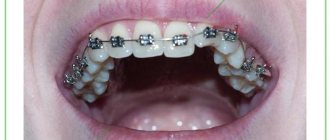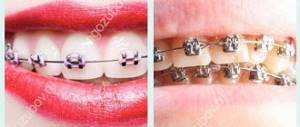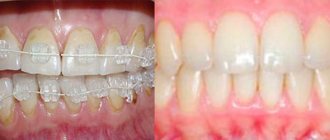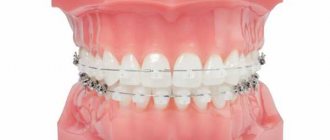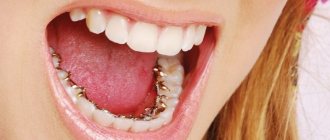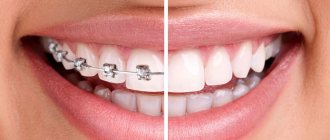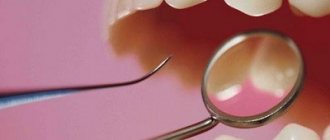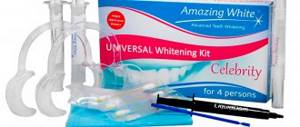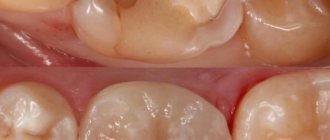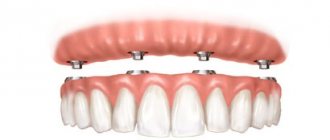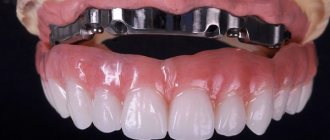Ceramic non-ligature and ligature braces are orthodontic structures that can correct uneven teeth and malocclusion. They all have different forces on the teeth, so the decision about what exactly to install is always made by the attending physician, based on the individual characteristics of the patient.
What are self-ligating braces?
The operating principle of a non-ligature construction is easiest to understand if you compare it with a ligature construction.
Classic ligature braces: clasps are fixed on the surface of each tooth and connected to each other by an orthodontic arch. The clasps and arch are attached to each other with fasteners - ligatures. They can be special rubber bands or wires. These elements gradually move the teeth and bite into the position specified by the orthodontist. This happens due to the teeth overcoming the frictional force. The disadvantage of ligatures is that during the treatment they need to be changed frequently, as they stretch, cease to perform their function, plus they lose their original aesthetic appearance - they change color.
To make orthodontic treatment more comfortable for the patient, manufacturers of dental corrective structures have developed braces without ligatures. They differ from classic ligature ones in the way the clasps and arches are connected: the latches in them are replaced with special latched covers built directly into the clasps themselves. It turns out that the locks seem to be strung on an arc, and not attached to it with “clothespins”.
During treatment with ligature-free braces, the frequency of visits to the dentist is reduced: the fixing elements in them do not fail, so the structure needs to be adjusted much less frequently.
Differences
Discarding advertising myths, we can highlight the main differences between ligature and non-ligature braces:
- Arc fixation method.
Some have ligatures, others have micro-locks.
- Size.
Ligatures are flatter, self-ligating, about 1 mm thicker due to built-in locks. In the first place, some discomfort is created by the ligatures, and in the second place, by the massive braces themselves.
- Efficiency.
Ligatures cope with the most complex anomalies, self-ligating simpler clinical cases.
- Correction.
Replacing rubber bands and wires and correcting the position of the arch of ligature braces takes longer. Patients with self-ligating appliances spend less time in the orthodontic chair.
- Care.
It is more difficult to care for ligatures; elastic bands and wires increase the time of hygiene procedures.
- Price.
Designs with micro-locks are two to three times more expensive.
Wearing ligature and non-ligature braces: what is the difference?
Both types of structures effectively perform their task - correct the pathology of teeth closure, return teeth to the anatomically correct position. But for the patient, the process of wearing them will be different.
- Non-ligature designs look neater, “lighter”, more inconspicuous: they have no additional elements, and the clasps themselves are smaller.
- Caring for self-ligating systems is much easier: metal and rubber ligatures often contain food fragments and need to be cleaned more thoroughly and for longer.
- The main difference we have already mentioned is the frequency of correction. When wearing classic ligature braces, you need to visit the orthodontist every three to four weeks, and when wearing non-ligature braces - every six to eight weeks. For many patients, this is a decisive moment when choosing an orthodontic system.
Photos of treatment stages on self-ligating braces
Braces care
Wearing self-ligating braces requires special oral care. For them, it is recommended to purchase a special toothbrush (preferably soft) and a brush. Brushing your teeth is required after every meal. When wearing braces, you should not overeat solid foods. You will also need to give up acidic foods and coloring drinks. Every 2-3 months when wearing braces, you need to visit your dentist.
Braces carefully chosen by an orthodontist will correct any defects in the oral cavity for several years and make your smile perfectly straight and your bite correct.
What materials are ligature-free braces made from?
Locks for self-ligating structures are made from the same materials as for classic ligature braces - metal, ceramics and artificial sapphires.
Metal self-ligating braces
They are the easiest to install and remove. These durable, reliable systems correct all malocclusion pathologies and effectively move teeth into the desired position. Cheaper than designs made from other materials, therefore popular with patients.
Self-ligating ceramic braces
They are made from durable white dental ceramics in different shades, so they look more attractive than metal ones. The clasps of such systems are invisible, since the ceramics merge with the tooth enamel. The only noticeable detail is the orthodontic arch. They have one drawback - fragility compared to structures made from other materials.
Sapphire self-ligating braces
Like ceramic ones, they are almost invisible on the teeth. They are, of course, not made from natural sapphires - otherwise their price would be very high. During production, a transparent artificial material is used, the characteristics of which are identical to sapphires. They reflect light and make your smile really sparkle. Sapphire braces are more often used in the treatment of complex malocclusion pathologies; they are stronger than ceramic ones.
How do braces work?
The principle of operation of any brace systems is as follows. They apply pressure to crooked teeth or jaw, thereby helping to straighten the dentition and correct abnormal position or shape of the jaw.
Structurally, such devices consist of direct braces and a metal arch with shape memory. A bracket is a small plate that is attached to the surface of the tooth from the outside or inside. A metal wire made of a shape memory material is attached to these plates. When it is fixed on uneven teeth, the arch strives to regain its correct position and puts pressure on the teeth, gradually displacing them.
Depending on the method of attaching the metal arch to the plates, ligature and self-ligating braces are distinguished. To understand the differences, you need to understand the design features of both systems.
Aesthetic system without ligatures - what is it?
It is widely believed that non-ligature braces are a type of aesthetic system. In fact, this is only partly true.
Aesthetic self-ligating braces include ceramic and sapphire designs. Metal ones, although they look more attractive than ligature systems due to small locks, can hardly be called aesthetic. They look neat, but are much more noticeable than designs made of ceramics and artificial sapphires.
Also, aesthetic non-ligature braces include lingual systems - they are attached to the “lingual”, inner surface of the teeth. Such designs are invisible and are often chosen by public people.
The only drawback of non-ligature aesthetic systems is their high price. In order to reduce it, dentists combine materials: in the frontal zone, sapphire or ceramic clasps are fixed on the upper teeth, and metal ones on the lower jaw, chewing teeth.
Flaws:
- gradually lose elasticity and require replacement of component elements;
- act slowly: teeth, moving, are forced to overcome friction;
- may lead to discomfort due to the fixed fixation of the arch;
- bulky design requires complex maintenance;
- food coloring can stain rubber bands;
- cannot be used for periodontal disease and periodontitis;
- the need for monthly visits to the doctor.
Rice. 1 Ligature braces
Main brands of self-ligating non-ligating braces
Popular brands of non-ligation systems include Damon, Clarity, Experience, In Ovation, H4.
Damon.
Perhaps the most famous brand of braces without ligatures. Its product line includes designs to solve any problems with bite and misalignment of teeth. The main advantage of these American systems is the damper mount developed by the company. It simplifies the archwire replacement process and reduces correction time.
Experience.
Japanese non-ligature designs, characterized by the small size of the clasps and their structure. Each clasp fits very tightly to the tooth enamel. Plus Experience controls the movement of each tooth.
Clarity SL.
Damon's main competitors. They are made of ceramic, but the groove in their clasps is made of stainless steel. This guarantees smooth sliding of the arc, as in metal systems. At the same time, they are classified as aesthetic systems, since they are invisible on the teeth. Treatment duration with Clarity SL is typically reduced by 25%. However, it all depends on the clinical picture.
In Ovation C.
These are ceramic non-ligature structures from the American company DENTSPLY. These systems are designed to prevent incorrect fixation. In Ovation C clasps are 100% protected from discoloration during wear - for this, the manufacturer coated them with a layer of zirconium dioxide.
H4.
Another self-ligating braces made in America. They are distinguished by a low profile of the locks and a minimum size of the groove for the orthodontic arch. Allows better control of treatment at the final stage.
Ligature
The device got its name from the Latin word ligatura, which translates as ligament.
With the help of ligature ligaments, the power arc acting on the teeth is attached to the braces themselves - base plates glued to the teeth with special dental cement.
Orthodontists use two types of ligaments - transparent or multi-colored elastic bands and wires made of steel, aluminum or silver:
- The first ones do not fix the arch strongly enough; they are used in the initial stages of treatment to correct the position of individual crowns.
- The latter are suitable for later stages and the final stage - correcting the bite and ensuring the correct position of the upper teeth relative to the lower ones.
Some patients complain that rubber bands and wires irritate the oral mucosa - the inside of the lips and cheeks. In addition, they need to be changed every month. Sometimes more often, since elastic fasteners tend to stretch and tear.
Rubber bands for braces
How are ligature-free systems installed?
The process of fixing self-ligating non-ligature structures is no different from installing classical ligature systems.
- Before fixing the structure, a full examination of the oral cavity is carried out; sometimes, to achieve the desired result of orthodontic treatment, teeth are removed and dentures are installed. All carious lesions must be removed and professional cleaning carried out.
- Locks of the chosen design are fixed to the teeth. This happens with the help of dental glue. This is the most critical stage: incorrectly installed locks will negatively affect the duration and quality of treatment.
- If necessary, the remaining glue is removed, and the clasps are finally secured to the teeth using a lamp with ultraviolet light.
- On the side, on the chewing teeth, orthodontic rings and locks are fixed.
- All installed locks are connected to each other by means of an orthodontic arch, which is fixed in their grooves.
Installation of the system takes about one hour. But the preparatory stage may well last for several weeks or even months - it all depends on the initial condition of the patient’s oral cavity.
Number of visits to the doctor during treatment
For those who choose non-ligature braces, there is a big bonus - this is the opportunity to visit the treating orthodontist less often in order to monitor the operation of the systems. It’s not for nothing that such devices are also called self-ligating, because they literally work on their own. Due to sliding clamps, the devices allow the arc to slide freely in the grooves of the plates; they gently regulate the force of pressing the arc on the teeth as the dentition is straightened.
You will have to visit a doctor to monitor the situation and make appropriate adjustments, provided that you have ligature-free systems, once every 7-8 weeks. In devices with ligatures, you need to see a dentist once every 3-4 weeks.
Which braces to choose - with or without ligatures?
Non-ligature braces look more aesthetically pleasing than classic ligature braces, reduce the number of visits to the orthodontist, correct the bite faster, move teeth more gently, and can be used for periodontal diseases. Thanks to the design of self-ligating systems, the process of their correction takes fifteen to twenty minutes. In addition, the absence of ligatures protects against pain that can occur if the orthodontist “tightens” the ligature.
The disadvantage of self-ligating structures is their high price. Apparently, for this reason, classic ligature systems are still very popular. They are especially often chosen by teenagers and young people, who, in addition to saving money, receive another bonus - the opportunity to experiment with the color of the ligatures, making their braces unique, emphasizing their individuality.
In general, when choosing an orthodontic system, doctors and patients are guided by two principles - the ability to effectively get rid of malocclusion pathology and the ability to pay for treatment. Both ligature and non-ligature constructions allow you to achieve the desired result.
Which ones are better?
Most orthodontists prefer non-ligature braces and consider them better. This is argued by the fact that the system is created on the basis of new technologies in the world of medicine. The methods of attaching braces have really changed recently. Thanks to the improvements, the work of specialists has become easier and faster.
However, biomechanical statistics indicate that arches in systems of different generations become unusable within exactly the same period of time. It is quite difficult to assess the separation effectiveness of one bracket structure from another. The pathology of a particular patient plays a major role. It serves as the basis for selection in each individual case.
The selection of a brace complex model is carried out with a specialist. He recommends a suitable device according to the patient's individual characteristics. A preliminary study of the clinical picture of the client’s dentition is carried out. According to the results obtained and analyses, the specialist offers model options to choose from. Depending on the financial situation and personal wishes, the final decision is provided to the client.
Braces are installed exclusively on healthy teeth. If it is necessary to treat periodontitis or other diseases of the teeth and gums, these problems are eliminated first. Once a completely healthy oral cavity is achieved, the system is installed.
Today, braces have earned great popularity because they are the most effective way to change congenital pathologies of the jaw. Regardless of the type of braces: ligature or non-ligature, they require careful care and regular monitoring by the attending physician. Only a systematic and planned approach can provide the desired result.
How to fix the effect?
Despite the fact that sometimes you have to wear braces for one and a half to two years, the teeth may try to return to their original place after they are removed. Most often, this situation occurs in those who decide to correct their bite as an adult.
The solution here is quite simple - the orthodontist installs special holding devices that are securely attached to the inner surface of the dentition. No one except you will even guess that the treatment is ongoing.
If you do not want to install permanent retention devices, you can opt for removable ones. They can only be worn at night so that the teeth get used to their new place.
Metal or sapphire
Self-ligating brackets today are made of metal or polycrystalline aluminum oxide (synthetic sapphire). Both of these materials have their pros and cons. Thus, the metal has higher strength and allows treatment to be completed in a shorter time. Also, the doctor can change the arches in a higher sequence, and also use steel arches. They are distinguished by high rigidity, plasticity, and the ability to form bends and loops of the desired configuration. Also, steel arches are very affordable.
Sapphire products require more careful handling. Replacement of arcs is done more delicately, using super-elastic products made of nitinol (an alloy of nickel and titanium), an alloy of nitinol and copper. However, for the patient, sapphire braces are always preferable. They are almost invisible, transparent, very smooth and stylish. This allows you to eliminate the psychological discomfort associated with wearing an unaesthetic metal system.
Treatment with orthodontist Irina Butorina
Enjoy the benefits of modern ligature-free braces! The world's leading manufacturers of orthodontic products are now working to improve the aesthetics and comfort level of braces. Self-ligating systems are an important step in this direction. You can undergo diagnostics and correct your bite using a sapphire, ceramic or metal self-ligating system from orthodontist Irina Butorina . An experienced doctor will help you choose a system that will suit you at a price and meet your aesthetic requirements. Sign up for a consultation by phone or using a special form on the website.
If you are interested in the offer, you can sign up for a free consultation right now.
Final table comparison of types of structures
| Type of design | Peculiarities | Price |
| Metal | Easy installation. Minimum cost. High efficiency. Noticeable. | The most affordable. |
| Ceramic | Matched to the color of the teeth. Unnoticeable. Durable. Effective due to good adhesion. | Lower than sapphire, lingual, non-ligated, but higher than metal ones. |
| Sapphire | Transparent. Almost invisible. Do not cause allergies. Durable. Suitable for snow-white teeth. | Higher than metal ones, not much higher than ceramics. |
| Lingual | Completely invisible. Effective treatment. Longer addiction. | Premium class |
| Self-ligating | Comfortable to wear. Do not require frequent visits to the doctor. Aesthetic. Can be made from different materials. Speed up treatment. | Premium class |
